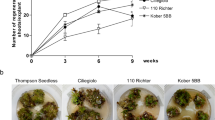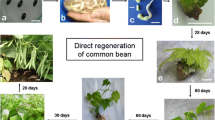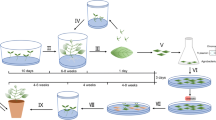Abstract
Melon (Cucumis melo L.) is widely considered as a recalcitrant species for genetic transformation. In this study, we developed different regeneration and transformation protocols and we examined the regeneration process at different steps by histological studies. The highest regeneration rate (1.13 ± 0.02 plants per explant) was obtained using cotyledon explants of the ‘Védrantais’ genotype on Murashige and Skoog (MS) medium supplemented with 0.2 mg/l 6-benzylaminopurine (BAP) and 0.2 mg/l dimethylallylaminopurine (2-iP). Agrobacterium tumefaciens-mediated transformations with the uidA reporter gene were realized on cotyledon explants cultivated in these conditions: 70–90% of explants expressed a transient GUS activity during the early stages of regeneration, however, only few transgenic plants were obtained (1.8–4.5% of stable transformation with the GV2260pBI101 strain). These results revealed a low capacity of melon GUS-positive cells to regenerate transgenic plants. To evaluate the influence of the Agrobacterium infection on plant regeneration, histological analyses were conducted on explants 2, 7, 15, and 28 days after co-culture with the GV2260pBI101 strain. Genetic transformation occurred in epidermal and sub-epidermal cells and reached the meristematic structures expressing a high level of GUS activity during 14 days of culture; but after this period, most of the meristematic structures showed premature cell vacuolization and disorganization. This disruption of the GUS-positive meristematic areas could be responsible of the difficulties encountered to regenerate melon plants after genetic transformation.



Similar content being viewed by others
References
Aarrouf J, Garcin A, Lizzi Y, El-Maataoui M (2008) Immunolocalization and histocytopathological effects of Xanthomonas arboricola pv. pruni on naturally infected leaf and fruit tissues of peach (Prunus persica L. Batsch). J Phytopathol 165:338–345
Abu-El-Heba GA, Hussein GM, Abdalla NA (2008) A rapid and efficient tomato regeneration and transformation system. Agric For Res 58:103–110
Adelberg JW, Rhodes BB, Skorupska HT, Bridges WC (1994) Explant origin affects the frequency of tetraploid plants from tissue-cultures of melon. Hortscience 29:689–692
Akasaka-Kennedy Y, Tomita K, Ezura H (2004) Efficient plant regeneration and Agrobacterium-mediated transformation via somatic embryogenesis in melon (Cucumis melo L.). Plant Sci 166:763–769
Anand A, Krichevsky A, Schornack S, Lahaye T, Tzfira T, Tang Y, Citovsky V, Mysore KS (2007) Arabidopsis VIRE2 INTERACTING PROTEIN2 is required for Agrobacterium T-DNA integration in plants. Plant Cell 19:1695–1708
Ayub R, Guis M, Ben Amor M, Gillot L, Roustan P, Latche A, Bouzayen M, Pech JC (1996) Expression of ACC oxidase antisense gene inhibits ripening of cantaloupe melon fruits. Nat Biotechnol 14:862–866
Bordas M, Montesinos C, Dabauza M, Salvador A, Roig AL, Serrano R, Moreno V (1997) Transfer of the yeast salt tolerance gene HAL1 to Cucumis melo L. cultivars and in vitro evaluation of salt tolerance. Transgenic Res 6:41–50
Castelblanque L, Marfa V, Claveria E, Martinez I, Perez-Grau L, Dolcet-Sanjuan R (2008) Improving the genetic transformation efficiency of Cucumis melo subsp. melo ‘Piel de Sapo’ via Agrobacterium. In: Pitrat M (ed) Cucurbitaceae 2008. Proceedings of the IXth EUCARPIA meeting on genetics and breeding of Cucurbitaceae, INRA, Avignon (France), May 21–24th 2008, pp 627–631
Chen WS, Chiu C, Liu HY, Lee TL, Cheng JT, Lin CC, Wu YJ, Chang HY (1998) Gene transfer via pollen-tube pathway for anti-fusarium wilt in watermelon. Biochem Mol Biol Int 46:1201–1209
Curuk S, Cetiner S, Elman C, Xia X, Wang Y, Yeheskel A, Zilberstein L, Perl-Treves R, Watad AA, Gaba V (2005) Transformation of recalcitrant melon (Cucumis melo L.) cultivars is facilitated by wounding with carborundum. Eng. Life Sci 5:169–177
Davis WE, Miller AR, Linerberger RD (1992) Studies on the effects of ethylene on transformation of tomato cotyledons (Lycopersicon esculentum Mill.) by Agrobacterium tumefaciens. J Plant Physiol 139:302–309
Dong JZ, Yang MZ, Jia SR, Chua NH (1991) Transformation of melon (Cucumis melo L.) and expression from the cauliflower mosaic virus-35S promoter in transgenic melon plants. Bio-Technology 9:858–863
Ezura H, Amagai H, Yoshioka K, Oosawa K (1992) Highly frequent appearance of tetraploidy in regenerated plants a universal phenomenon in tissue-cultures of melon (Cucumis melo L.). Plant Sci 85:209–213
Ezura H, Hitomi A, Higashi K, Sato T, Kubota M (1997) Introduction of ACC synthase antisense gene to muskmelon (Cucumis melo L. var. reticulatus). In: Abak K, Buyukalaca S (eds) First international Symposium on Cucurbits. Adana, Turkey, Abstract
Ezura H, Yuhashi K-I, Yasuta T, Minamisawa K (2000) Effect of ethylene on Agrobacterium tumefaciens-mediated gene transfer to melon. Plant Breed 119:75–79
Fang GW, Grumet R (1990) Agrobacterium tumefaciens mediated transformation and regeneration of muskemelon plants. Plant Cell Rep 9:160–164
Fang GW, Grumet R (1993) Genetic-engineering of potyvirus resistance using constructs derived from the zucchini yellow mosaic virus coat protein gene. Mol Plant Microbe Interact 6:358–367
Fuchs M, Mc-Ferson JM, Tricoli DM, Mc-Master JR, Deng RZ, Boeshore ML, Reynolds JF, Russell PF, Quemada HD, Gonsalves D (1997) Cantaloupe line CZW-30 containing coat protein genes of cucumber mosaic virus, zucchini yellow mosaic virus, and watermelon mosaic virus-2 is resistant to these three viruses in the field. Mol Breed 3:279–290
Fulton TM, Chunwongse J, Tanksley SD (1995) Microprep protocol for extraction of DNA from tomato and other herbaceous plants. Plant Mol Biol Rep 13:207–209
Gaba V, Kless H, Antignus L (1992) Transformation of melon by particle acceleration. Suppl Plant Physiol 99:137
Gaba V, Schlarman E, Elman C, Sagee O, Watad AA, Gray DJ (1999) In vitro studies on the anatomy and morphology of bud regeneration in melon cotyledons. In vitro Cell Dev Biol Plant 35:1–7
Gaba V, Zelcer A, Gal-on A (2004) Cucurbit technology—the importance of virus resistance. In Vitro Cell Dev Biol Plant 40:346–358
Galbraith DW, Harkins K, Knapp S (1991) Systemic endopolyploidy in Arabidopsis thaliana. Plant Physiol 96:985–989
Galperin M, Patlis L, Ovadia A, Wolf D, Zelcer A, Kenigsbuch D (2003) A melon genotype with superior competence for regeneration and transformation. Plant Breed 122:66–69
Gelvin SB (2003) Agrobacterium-mediated plant transformation: the biology behind the gene jockey tool. Microbiol Mol Biol Rev 67:16–37
Gonsalves C, Xue B, Yepes M, Fuchs M, Ling KS, Namba S, Chee P, Slightom JL, Gonsalves D (1994) Transferring cucumber mosaic virus-white leaf strain coat protein gene into Cucumis melo L. and evaluating transgenic plants for protection against infections. J Am Soc Hortic Sci 119:345–355
Gray D, Hiebert E, Kelley KT, Compton ME, Gaba VP (1995) Comparison of methods to transform embryogenic cotyledons of melon. Hortscience 30:788
Guis M, Latche A, Pech JC, Roustan JP (1997) An efficient method for production of diploid cantaloupe charentais melon (Cucumis melo L. var. cantaloupensis) by somatic embryogenesis. Sci Hortic 69:199–206
Guis M, Amor MB, Latche A, Pech JC, Roustan JP (2000) A reliable system for the transformation of cantaloupe charentais melon (Cucumis melo L. var. cantalupensis) leading to a majority of diploid regenerants. Sci Hortic 84:91–99
Han JS, Kim CK, Park SH, Hischi KD, Mok IG (2005) Agrobacterium-mediated transformation of bottle gourd (Lagenaria siceraria Standl.). Plant Cell Rep 23:692–698
Hansen G (2000) Evidence for Agrobacterium-induced apoptosis in maize cells. Mol Plant Microbe Interact 13:649–657
Hao J, Niu Y, Yang B, Gao F, Zhang L, Wang J, Hasi A (2010) Transformation of a marker-free and vector-free antisense ACC oxidase gene cassette into melon via the pollen-tube pathway. Biotechnol Lett 33:55–61
Hellens R, Mulineaux P, Klee H (2000) A guide to Agrobacterium binary Ti vectors. Trends Plant Sci 5:446–451
Huttner E, Tucker W, Vermeulen A, Ignart F, Sawyer B, Birch R (2001) Ribozyme genes protecting transgenic melon plants against potyviruses. Curr Issues Mol Biol 3:27–34
Jefferson RA, Kavanagh TA, Bevan MW (1987) GUS fusions: β-glucuronidase as a sensitive and versatile gene fusion marker in higher plants. EMBO J 6:3901–3907
Khanna HK, Paul JY, Harding RM, Dickman MB, Dale JL (2007) Inhibition of Agrobacterium-induced cell death by antiapoptotic gene expression leads to very high transformation efficiency of banana. MPMI 20:1048–1054
Kintzios S, Sereti E, Bluchos P, Drossopoulos JB, Kitsaki CK, Liopa-Tsakalidis A (2002) Growth regulator pre-treatment improves somatic embryogenesis from leaves of squash (Cucurbita pepo L.) and melon (Cucumis melo L.). Plant Cell Rep 21:1–8
Liborio Stipp LC, Januzzi Mendes BM, Stefano Piedade SMD, Martinelli Rodriguez AP (2001) In vitro morphogenesis of Cucumis melo var. inodorus. Plant Cell Tissue Organ Cult 65:81–89
Lippincott BB, Whatley MH, Lippincott JA (1977) Tumor induction by Agrobacterium involves attachment of bacterium to a site on host plant-cell wall. Plant Physiol 59:388–390
Martin A, Troadec C, Boualem A, Rajab M, Fernandez R, Morin H, Pitrat M, Dogimont C, Bendahmane A (2009) A transposon-induced epigenetic change leads to sex determination in melon. Nature 461:1135–1138
Murashige T, Skoog F (1962) A revised medium for rapid growth and bioassays with tobacco tissue cultures. Physiol Plant 15:473–497
Nam J, Matthysse AG, Gelvin SB (1997) Differences in susceptibility of Arabidopsis ecotypes to crown gall disease may result from a deficiency in T-DNA integration. Plant Cell 9:317–333
Ntui VO, Khan RS, Chin DP, Nakamura I, Mii M (2010) An efficient Agrobacterium tumefaciens-mediated genetic transformation of Egusi melon (Colocynthis citrullus L.). Plant Cell Tiss Organ Cult 103:15–22
Nugent PE (1994) Tetraploid ‘planters Jumbo’ melon lines C883-M6-4x. Hortscience 29:47–48
Nunez-Palenius HG, Cantliffe DJ, Huber DJ, Ciardi J, Klee HJ (2006) Transformation of a muskmelon ‘Galia’ hybrid parental line (Cucumis melo L. var. reticulatus Ser.) with an antisense ACC oxidase gene. Plant Cell Rep 25:198–205
Nunez-Palenius HG, Gomez-Lim M, Ochoa-Alejo N (2008) Melon fruits: genetic diversity, physiology and biotechnology features. Biotechnology 28:13–55
Papadopoulou E, Little HA, Hammar SA, Grumet R (2005) Effect of modified endogenous ethylene production on sex expression bisexual flower development and fruit production in melon (Cucumis melo L.). Sex Plant Reprod 18:131–142
Pech JC, Bernadac A, Bouzayen M, Latche A, Dogimont C, Pitrat M (2007) Melon Biotechnology in Agriculture and Forestry. In: Pua EC, Davey MR (eds) Transgenic Crops V. vol 60. chap I.9, pp 209–240
Schulze J, Balko C, Zellner B, Koprek T, Hansch R, Nerlich A, Mendel RR (1995) Biolistic transformation of cucumber using embryogenic suspension cultures: long-term expression of reporter genes. Plant Science 112:197–206
Silva JA, da Costa TS, Lucchetta L, Marini LJ, Zanuzo MR, Nora L, Nora FR, Twyman RM, Rombaldi CV (2004) Characterization of ripening behavior in transgenic melons expressing an antisense 1-aminocyclopropane-1-carboxylate (ACC) oxidase gene from apple. Postharvest Biol Tex 32:263–268
Veena Jiang H, Doerge RW, Gelvin SB (2003) Transfer of TDNA and Vir proteins to plant cells by Agrobacterium tumefaciens induces expression of host genes involved in mediating transformation and suppresses host defence gene expression. Plant J. 35:219–236
Wolf D, Matzevitch T, Steinitz B, Zelcer A (2001) Why is it difficult to obtain transgenic pepper plant? In: Sorvari S et al (eds) Proc.IV IS on In Vitro Cult. & Hort. Breeding ISHS, Leuven, pp 229–233
Wu HW, Yu TA, Raja JAJ, Christopher SJ, Wang SL, Yeh SD (2010) Double-virus resistance of transgenic oriental melon conferred by untranslatable chimeric construct carrying partial coat protein genes of two viruses. Plant Dis 94:1341–1347
Yalcin-Mendi NY, Ipek M, Kacan H, Curuk S, Sari N, Cetiner S, Gaba V (2003) A histological analysis of regeneration in watermelon. J Plant Biochem Biotechnol 12:147–150
Yalcin-Mendi NY, Ipek M, Serbest-Kobaner S, Curuk S, Aka Kacar Y, Cetiner S, Gaba V, Grumet R (2004) Agrobacterium-mediated transformation of Kirkagac 637 a recalcitrant melon (Cucumis melo) cultivar with ZYMV coat protein encoding gene. Eur J Hortic Sci 69:258–262
Yang AF, Su Q, An LJ, Liu JF, Wu W, Qiu Z (2009) Detection of vector-and selectable marker-free transgenic maize with a linear GFP cassette transformation via the pollen-tube pathway. J Biotechnol 139:1–5
Yee S, Stevens B, Coleman S, Seabrook J, Li X (2001) High-efficiency regeneration in vitro from potato petioles with intact leaflets. Am J Potato Res 78:151–157
Yoshioka K, Hanada K, Harada T, Minobe Y, Oosawa K (1993) Virus-resistance in transgenic melon plants that express the cucumber mosaic-virus coat protein gene and in their progeny. Jpn J Breed 43:629–634
Zhou GY, Weng J, Zeng YS, Huang JG, Qian SY, Liu GL (1983) Introduction of exogenous DNA into cotton embryos. Meth Enzymol 101:433–481
Author information
Authors and Affiliations
Corresponding author
Additional information
Communicated by A.-C. Schmit.
Rights and permissions
About this article
Cite this article
Chovelon, V., Restier, V., Giovinazzo, N. et al. Histological study of organogenesis in Cucumis melo L. after genetic transformation: why is it difficult to obtain transgenic plants?. Plant Cell Rep 30, 2001–2011 (2011). https://doi.org/10.1007/s00299-011-1108-9
Received:
Revised:
Accepted:
Published:
Issue Date:
DOI: https://doi.org/10.1007/s00299-011-1108-9




